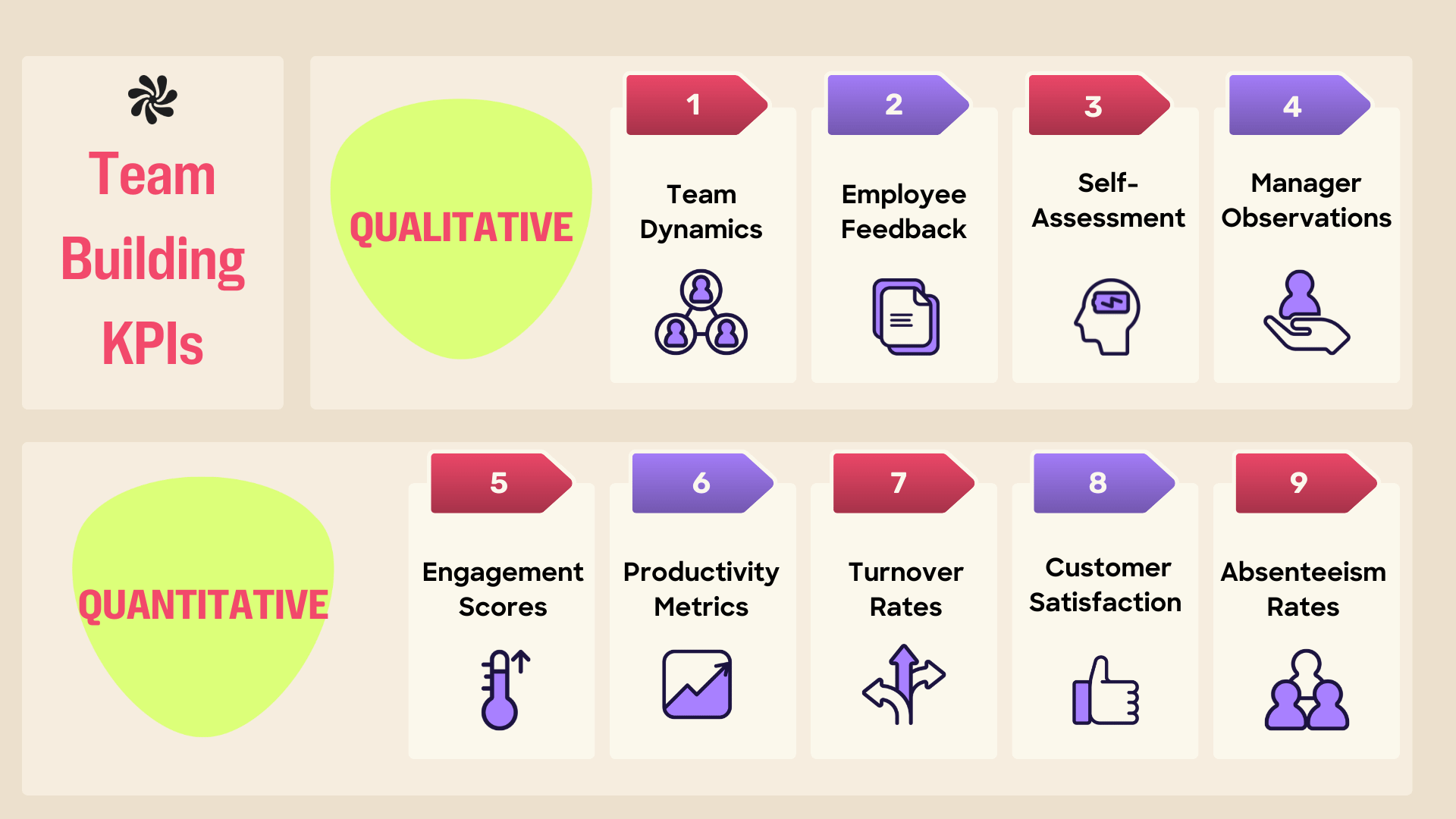How to Run an Effective Team Building Workshop: Tips and Tricks for Facilitating
Last Updated May 9, 2025


Designing an impactful team-building workshop isn’t just about picking the right activities. It’s about understanding your team’s unique needs and creating a space where growth and connection can thrive.
Think of it like this: If you're in an atmosphere where you don't feel comfortable talking to the other people around you or sharing your valuable ideas — how likely are you to stick around? Probably not very. You might spend your off-time looking for another role in another place that better fits your personality.
Whether you're trying to boost cross-department communication, onboard new employees, or prepare for a large project, your workshop should be carefully planned to meet those goals. When you tailor the experience to your team and their specific challenges, the impact will resonate far beyond the event itself.
Ready to design a workshop that delivers real results? Let’s break down the steps to get there.
Phase 1: Design an Impactful Team-Building Workshop
It takes forethought and planning to run a successful team-building workshop. You need to combine analytical thinking with compassion to determine if these exercises will succeed. While the planning process can be lengthy, your efforts are more likely to pay off when the workshop is tailored to what your employees need, not what some employees elsewhere might need.
Step 1: Assess Your Team's Needs
Before deciding to run a team building workshop, it's a good idea to understand your "why." Where do you see room for improvement, and how can a team-building workshop assist? Is there a need for collaboration between departments? Have you recently onboarded new employees and want to provide a platform for everyone to get to know one another? Or is a big project coming up requiring many employees to work together?
Once you understand the purpose of running a team-building workshop in your organization, it's easier to outline your goals, select appropriate activities, and include the right employees.
Step 2: Set Measurable Goals
Next, define the objectives for the team-building workshop. Consider using the SMART system to set goals, in which each objective meets five criteria: specific, measurable, attainable, relevant, and time-based. SMART goals make it easier to review the results of your team-building workshop.
Some examples of potential SMART objectives for a team-building workshop include:
- Increasing collaboration between departments by 10% over the next two months using techniques from the team-building workshop
- Upskilling employees with public speaking and communication skills necessary to run regular management meetings
- Teaching employees to resolve differences constructively, with a goal to reduce employee conflicts by 40% over the next month.
Step 3: Choose Engaging and Purposeful Exercises
Activities will likely be the bulk of the workshop. You want to select ones that align directly with its purpose. Choosing the right exercises can determine whether your employees progress toward your ultimate objectives.
Event team building activities examples
- Create realistic work scenarios that require lots of communication, and ask participants to collaborate toward a solution.
- Teach employees how to recognize varying communication styles and the best way to use them to address conflicts or interact with one another.
- Assign each employee a role different from their everyday responsibilities and have them work together to complete a project.
- Take employees outside the office for an activity, such as an escape room challenge or scavenger hunt, that encourages collaboration in a fun atmosphere.
Step 4: Logistics and Planning
Now it's time to dive into event logistics.
It's usually a good idea to start by securing buy-in from management by explaining why a team-building workshop can benefit the organization and what you hope to achieve.
Leadership support is helpful because it means they are more likely to give their team time to participate. The workshop may also require some monetary resources. For instance, if you plan on hiring outside experts to lead the workshop or plan on outside activities, your organization may need to fund the costs. If supervisors and leaders are supportive, it's easier to get approval for the appropriate funds.
Next, decide on a date for the workshop. Consider scheduling it when you know participants aren't likely to have strict deadlines. That way, you'll see greater employee participation.
Phase 2: Facilitate Engaging Team Building Sessions
Building camaraderie works best when employees put their all into the activities. You want them to feel excited about the activity and comfortable sharing their thoughts and insights throughout every exercise. These next steps help you create a space where that sort of open bonding is more likely to happen than in a typical meeting.
Step 5: Set the Stage With a Safe and Inclusive Environment
Start by making everyone feel welcome. That can be as simple as walking around, introducing yourself, and thanking everyone for joining. When you take the time to connect with people one-on-one, you'll find they're more likely to open up as the workshop unfolds.
Of course, that may not be possible if you're hosting a large workshop with dozens of people. Consider starting with a fun introduction that gets people laughing. You could share a relatable story about team building gone wrong or how you personally struggle with something you're hoping to achieve through the workshop.
If you hire outside experts to lead some of your activities, try to choose people from diverse backgrounds who offer relatable perspectives. When employees see you value everyone's input, they're more likely to engage fully.
Step 6: Icebreakers and Warm-Ups to Spark Participation
Workshops can feel a little like, well, work. You join a group of colleagues or employees, and they know you from your work persona, not by how you act when you're in your home environment. If participants don't know each other very well, they may feel self-conscious about sharing their thoughts.
You can help break the ice and help everyone relax with a gentle warm-up activity. One idea that can help everyone learn a little about one another is sharing something interesting about themselves, such as their first job or worst travel story. The warm-up activity helps get the blood pumping so everyone's attentive from the beginning of the workshop.
Tips and Techniques for Running Team Building Sessions
As you move from icebreakers and warm-up activities into the meat of your workshop, keep a few tips in mind. These suggestions help keep participants engaged while working toward your objectives.
Designate activity leaders
Who is running your activities? Is it you, an outside expert, or another employee? Make sure everyone knows who the leader is so they know to listen as they outline the guidelines for the workshop and each exercise.
Explain the purpose of the workshop
It's helpful to explain why you're holding a team-building workshop and why you think it's essential to the organization. Discuss things you believe effective team building could improve, and be honest.
For instance, if you've noticed dwindling productivity or a need for more communication between departments, say so. When employees understand the problems, they're more likely to work toward resolving them (and be open to the strategies presented in the workshop).
Encourage everyone to participate
Sometimes, the most vocal employees become the standout participants in a workshop. Extroverted participants aren't shy about sharing their thoughts and are quick to contribute their two cents.
However, you want everyone to participate, not just a handful of people. Make a point of encouraging everyone to collaborate. If you notice some employees hanging back, call on them to join in the activities. You might even ask them to be a point person or leader for an activity.
Take a wellness moment
When your team first joins the workshop, they may still have work on the brain. Give everyone a chance to completely disconnect from their responsibilities with a mindfulness moment. You might try a short breathwork or stretching exercise to get everyone to relax and truly embrace the magic of what's to come.
Have an agenda
It helps to share an outline for the workshop so participants know what to expect, especially if you expect it to last longer than an hour or two. For half-day or full-day workshops, list each activity, its leader, and duration. An agenda helps keep things on schedule so you cover everything during the workshop.
Phase 3: Measure and Evaluate Success
The workshop is complete! You had a great time, and you're pretty sure your team did, too. Now it's time to find out by getting their honest thoughts so you can evaluate how well your team-building event met your objectives.
Step 7: Gathering Participant Feedback
Anytime you run a workshop or other event, learning what people thought about the experience is useful. Their feedback can alert you to potential improvements for your next event and what activities they felt added value. Gather this data through a post-event survey or workshop evaluation.
A post-event survey requests employees to evaluate the workshop. You'll provide a list of questions, which participants can reply to using a rating scale, multiple choice answers, or their own words. You can share post-event surveys on paper or electronically. Remember to allow anonymity. Doing so encourages authentic responses.
Step 8: Track Key Performance Indicators
In the pre-planning phase of your workshop, you set a few SMART goals for your workshop. Now's the time to revisit them and measure whether you reached your objectives. Review your SMART goal worksheet and use the evaluation techniques to measure changes in employee engagement, productivity, and collaboration.
Evaluate key performance indicators at several intervals after the workshop ends. For instance, you could perform an analysis the day after the workshop, one week later, and then monthly for the next quarter. Compare the results to your goals to see if you're on target or if a refresher workshop may be in order.
Keep in mind that your results may decline over time. A single workshop may not resolve every issue you're trying to fix. Making team-building events a regular part of the organizational culture may guide employees toward greater productivity and stronger relationships with colleagues.
Get More of This Team Building Series:
Step 9: Communicating Results
Share employee feedback and key performance metric results with management and participants. Let them see the value of team-building activities. Consider assembling a slide deck of results for management that includes informative statistics about the program's return on investment (ROI), participation levels, and employee comments.
You can also share success stories from people who joined the workshop and learned new tricks and techniques they've implemented into their daily work routines. For instance, an employee may have picked up a helpful tip for leading meetings that improved audience engagement. Perhaps a new hire connected with a mentor at the workshop. Those are very positive things to share with management and employees that can make a strong case for regularly holding future seminars or team-building exercises.
Phase 4: Sustain Momentum Beyond the Workshop
As the days pass, employees may focus on other things besides the workshop. That's only natural as they return to their regular work responsibilities. However, that doesn't mean you can't keep the momentum going and make a positive, long-lasting change in your organization.
Step 10: Translating Insights Into Concrete Next Steps
Consider gathering all the data from your workshop, including your goals, results, and participant feedback. Then, look at how well the workshop addressed the issues you hoped to improve. Is there room for additional progress? Could you hold another workshop and focus exclusively on those areas? Would ongoing exercises and team-building events enhance the longevity of your results?
Write down some potential next steps, and consider how to incorporate them. For instance, maybe you'll hold a refresher activity in several weeks that participants can join to discuss how they're implementing team-building techniques into their workday. You could also make the team-building workshop a regular part of the employee onboarding process and schedule it for new hires every quarter.
As you identify the next steps, discuss them with the management team. Getting approval and support makes it easier to bring future activities to fruition.
Step 11: Embedding Team Building into the Workplace Culture
Holding workshops and team-building activities is a great way to promote stronger employee relationships and collaboration, but it's not enough to change your organization's culture. If you're looking for long-term, permanent changes, incorporate values and strategies that emphasize the importance of a team culture.
One way to further workplace collaboration is to create an atmosphere of trust. Encourage employees to share their feelings and work together to resolve issues. People in a supportive and open environment free from bias won't feel the need to be reticent about workplace problems.
Another technique for building strong teams is transparency. Encourage managers and supervisors to be clear about workplace expectations and objectives. Set short and long-term goals for employees to work toward and provide regular progress evaluations. When workers know what you expect, there's less room for miscommunication that hurts everyone in the organization.
While you don't need to hold weekly workshops to instill team values, you can encourage management and staff to engage in other activities that promote collaboration. Something as simple as having regular team lunches, happy hours, or even a volunteer day can help employees get to know one another outside their daily responsibilities. That makes workplace collaboration much easier and provides for a positive environment.
A Team That Moves Together, Stays Together
Team-building facilitation is all about proper planning and execution. Start by identifying where you see a lack of camaraderie, then design your workshop around those issues. By pinpointing areas of improvement, you get straight to the heart of the problem.
Group wellness activities are a fantastic way to provide the foundation for an effective team-building workshop. A quick fitness challenge, mindful yoga, or an improv game can lighten the atmosphere and dial up the fun. Consider using those activities to loosen everyone up before diving into more comprehensive exercises.
While improving employee relationships through your team-building workshop, consider other ways you can benefit employee wellbeing. Wellhub offers wellness solutions that promote holistic employee wellbeing through access to physical and mental wellness benefits. To learn more about our solutions, speak to a Wellhub Wellbeing Specialist!

Company healthcare costs drop by up to 35% with Wellhub*
See how we can help you reduce your healthcare spending.
[*] Based on proprietary research comparing healthcare costs of active Wellhub users to non-users.
You May Also Like:
- 10 Conflict Resolution Strategies for the Workplace
- Workplace Conflict Examples (+ Resolutions)
- 7 Ways to Deal With Passive-Aggressive Coworkers
References:
- BLS. (2023). Average Hours per Day Spent in Selected Activities on Days Worked by Employment Status and Sex. Retrieved on August 13, 2024, from https://www.bls.gov/charts/american-time-use/activity-by-work.htm.
- How to Run Effective Team Meetings: 10 Tips + Free Agenda. (2022, April 6). Range. Retrieved on August 13, 2024, from https://www.range.co/blog/how-to-run-a-team-meeting.
- Lanier, S. (2023, July 17). How To Build Team Culture at Your Company. HubSpot. Retrieved on August 13, 2024, from https://blog.hubspot.com/marketing/team-culture.
- Making Your Events More Inclusive and Diverse. (n.d.). Eventbrite. Retrieved on August 13, 2024, from https://www.eventbrite.com/blog/asset/inclusive-diverse-events/.
- Post event survey questions: What to ask and why - Qualtrics. (2023, December 8). Qualtrics. Retrieved on August 13, 2024, https://www.qualtrics.com/experience-management/research/post-event-survey-questions/.
- Shen, R. (2024, June 5). 12 SMART Goals Examples for Better Team building. Success in Depth. Retrieved on August 13, 2024, from https://successindepth.com/smart-goals-for-team-building/.
- Team Building Meeting: Tips on how to run it successfully. (2024, July 22). Fellow.app. Retrieved on August 13, 2024, from https://fellow.app/blog/meetings/team-building-meeting-tips-on-how-to-run-it-successfully/.
- The Design of a Workshop: A Guide to Designing Workshops that Engage - - Innovation Training | Design Thinking Workshops. (2024, February 1). Innovation Training | Design Thinking Workshops. Retrieved on August 13, 2024, from https://www.innovationtraining.org/the-design-of-a-workshop-a-guide-to-designing-workshops-that-engage/.
- The Role of Team Culture in Building High-Performing Teams | Penn LPS Online. (2024, March 21). University of Pennsylvania. Retrieved on August 13, 2024, from https://lpsonline.sas.upenn.edu/features/role-team-culture-building-high-performing-teams.
Category
Share

The Wellhub Editorial Team empowers HR leaders to support worker wellbeing. Our original research, trend analyses, and helpful how-tos provide the tools they need to improve workforce wellness in today's fast-shifting professional landscape.
Subscribe
Our weekly newsletter is your source of education and inspiration to help you create a corporate wellness program that actually matters.
Subscribe
Our weekly newsletter is your source of education and inspiration to help you create a corporate wellness program that actually matters.
You May Also Like

601 Fun Team Names for Work (Funny & Inspiring) | Wellhub
Find the perfect team name! Our ultimate list of 601 names includes options for Sales, HR, IT, projects, trivia, & funny groups. Boost morale and collaboration.

Virtual Escape Rooms for Team Building | Wellhub
Discover how virtual escape rooms boost collaboration, problem-solving, and team morale with our top picks for fun, engaging team-building activities!

12 Team Building Activities Your Team Will Love | Wellhub
12 fun and effective team building activities that build trust, engagement, and culture for every type of workplace.